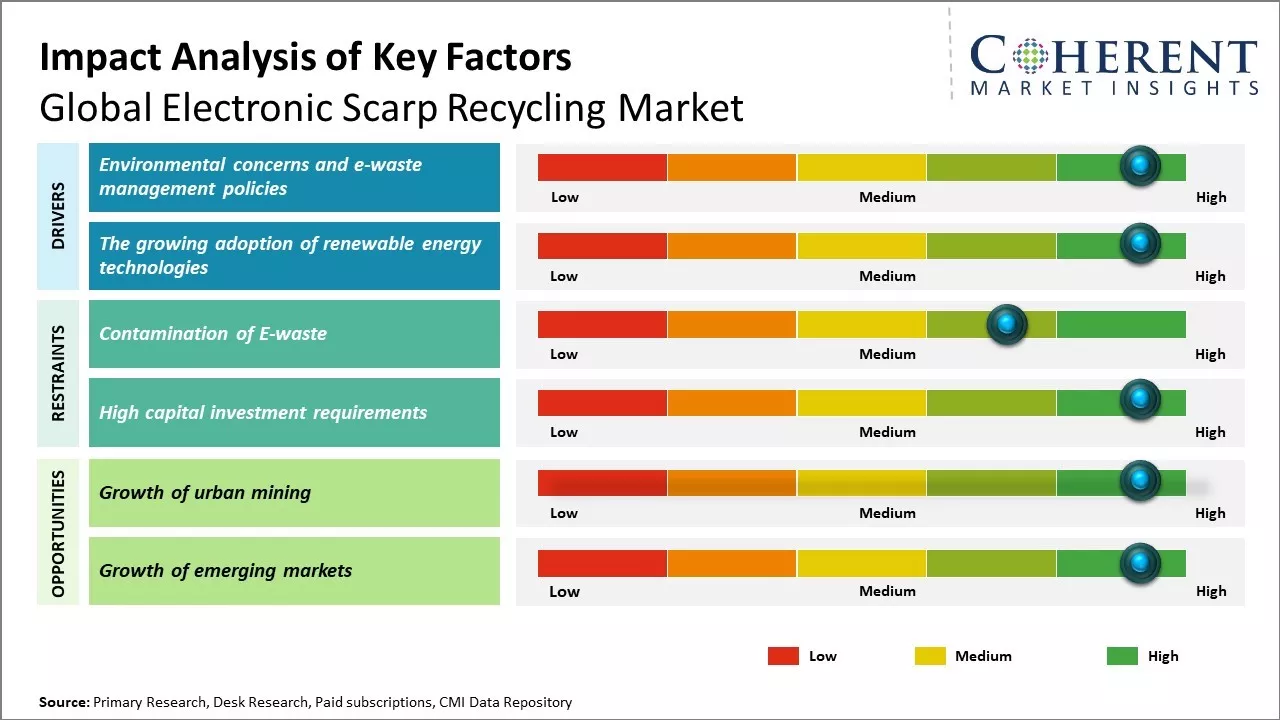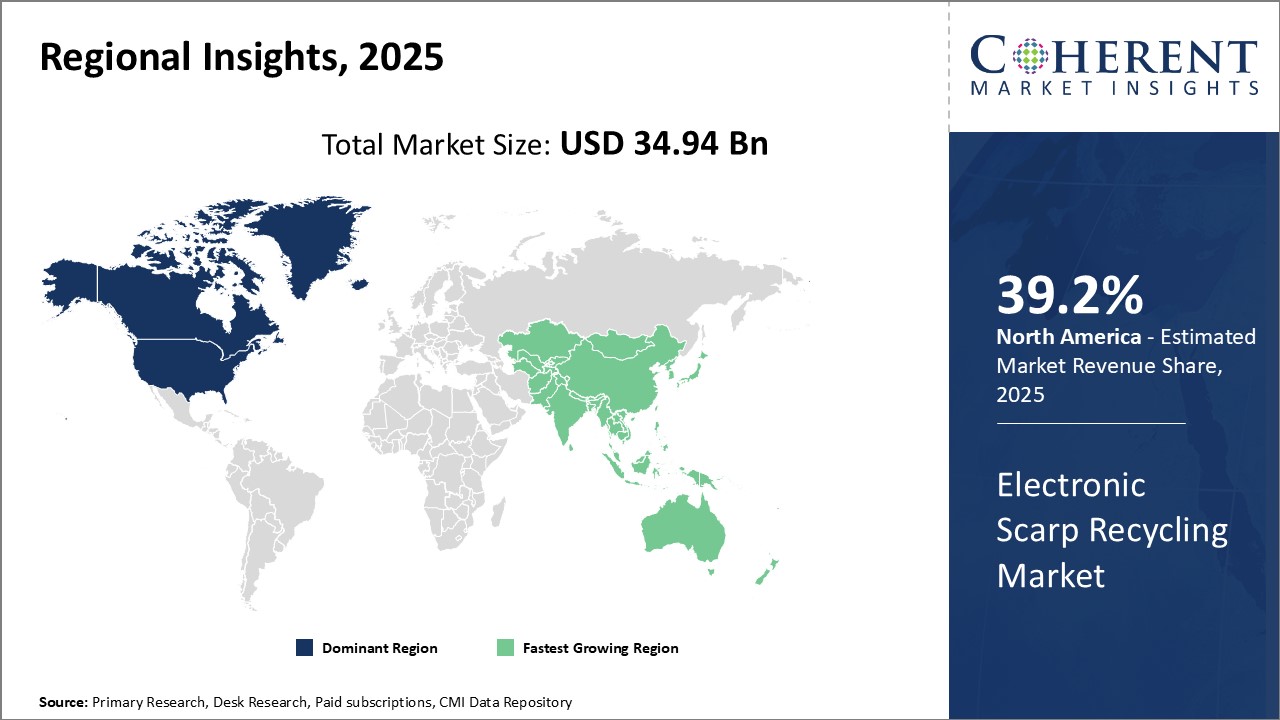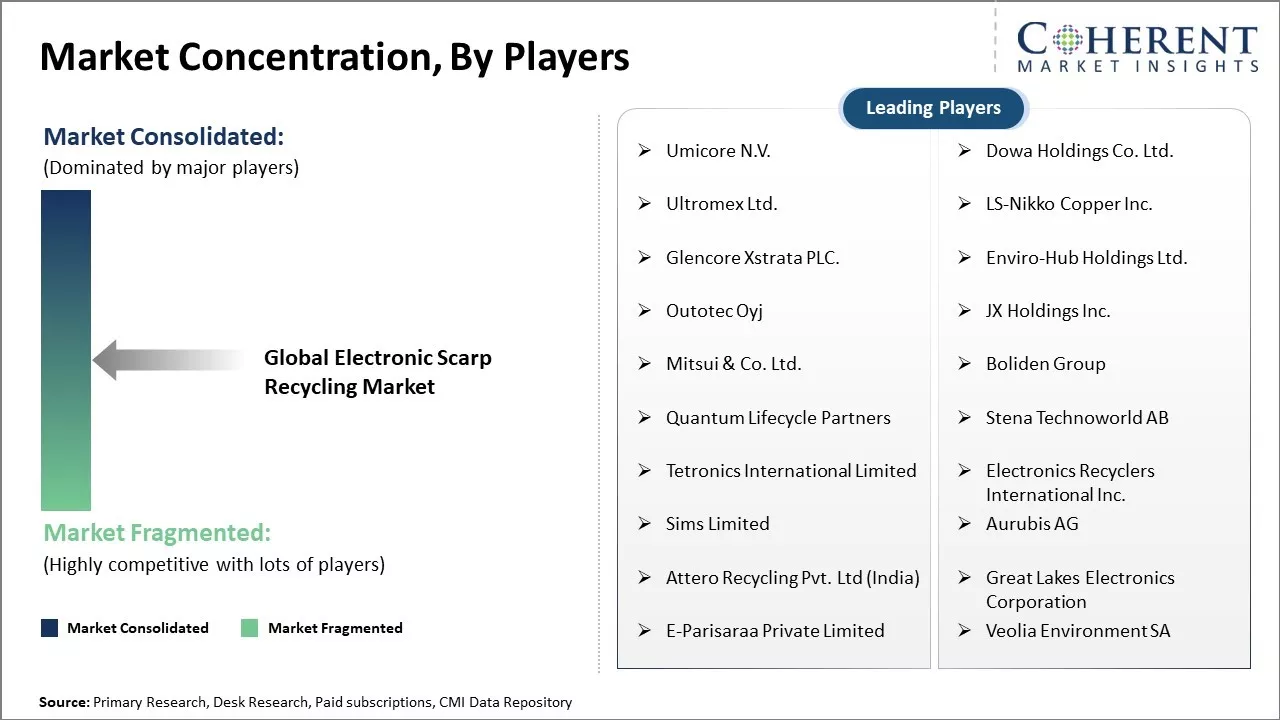The Electronic Scrap Recycling Market size is estimated to be valued at USD 34.94 Bn in 2025 and is expected to reach USD 57.25 Bn by 2032, exhibiting a compound annual growth rate (CAGR) of 7.3% from 2025 to 2032.

To learn more about this report, Download Free Sample
The increase in the quantity of electronics manufactured and used globally has resulted in augmented production of electronic waste considering that modern devices have a shorter life span and are easily replaceable. The global revenue resulting from e-scrap recycling is expected to increase significantly in the coming years. Increased focus on the responsible management of e-waste dismantling and mounting concern over the impacts of poorly dismantled e-waste is driving some leading undermine actors to adopt more sustainable policies for reclaiming materials from e-waste. For instance, According to the Global E-waste Monitor 2024, published by the United Nations (UNITAR, ITU, and others), the value of raw materials in global e-waste was estimated at USD 91 billion in 2022, yet only 22.3% of e-waste was properly recycled. Additional investment for the creation of recycling technologies and the growth of systems for collecting obsolete electronic devices will further enhance the recycling of electronic waste.
|
Event |
Description and Impact |
|
I ncreasing Global E-waste Generation |
|
|
Growing Awareness of Environmental and Health Impacts |
|
|
Technological Advancements in Recycling Processes |
|
Uncover macros and micros vetted on 75+ parameters: Get instant access to report
Artificial intelligence (AI) plays a transformative role in electronic scrap recycling by enhancing efficiency, accuracy, and sustainability. AI-powered systems streamline sorting processes by identifying and separating valuable materials from waste with high precision. In logistics, AI optimizes routes and inventory management, reducing costs and environmental impact. Automated diagnostics assess device functionality, enabling better reuse and resale decisions.
In August 2025, Techbros Electronic Recycling launched an AI-driven, R2v3-certified ITAD and e-scrap processing facility in Scottsdale, Arizona. The company uses AI across operations, including logistics, inventory management, device diagnostics, downstream tracking, and marketing.
In terms of Product Type, Computers & Laptops is expected to contribute 34.7% share of the Electronic Scarp Recycling Market Demand in 2025, owing to the growing adoption of digital technology across industries and households. The increase in the quantity of electronics manufactured and used globally has resulted in augmented production of electronic waste considering that modern devices have a shorter life span and are easily replaceable. The global revenue resulting from e-scrap recycling is expected to increase significantly in the coming years. Increased focus on the responsible management of e-waste dismantling and mounting concern over the impacts of poorly dismantled e-waste is driving some leading undermine actors to adopt more sustainable policies for reclaiming materials from e-waste. Additional investment for the creation of recycling technologies and the growth of systems for collecting obsolete consumer electronic devices will further enhance the recycling of electronic waste.
In terms of Source, the Commercial Segment is expected to contribute 39.3% share to the Electronic Scarp Recycling Market Growth in 2025, owing to the large quantity of e-waste generated from corporate offices, retail stores, warehouses, and other commercial establishments. Modern businesses heavily incorporate technology into everyday activities, along with maintaining copious amounts of electronic asset inventories, such as computers, printers, copiers, televisions, and other devices. Newly developed technologies are introduced into the market at a surprisingly greater rate than firms can incorporate them into their systems, which in turn increases their productivity. This inherent wastefulness from the business sector contributes to the constant influx of scrap within the recycling industry. Moreover, businesses actively seek efficient ways to comply with some environmental policies, and therefore, contract reputable recyclers to deal with obsolete e-waste. This growth in the use of technology is expected to result in an increasing volume of electronic scrap generated by the commercial sector over time.

To learn more about this report, Download Free Sample
North America is expected to maintain its dominance in the global Electronic Scarp Recycling Market Value, with a projected market share of 39.2% by 2025. This growth is largely attributed to the region’s high volume of e-waste generated due to the region’s developed e-waste manufacturing base and extensive electronics consumer market. Additionally, the region has tough approaches to managing e-waste, which Improvement in recycling infrastructure and facilities has resulted due to the enforcement of such policies. Innovative e-waste recycling processes to recover maximum economically valuable materials are being developed by North American firms. This allows the region to service effectively both local recyclers and affluent international recyclers, therefore, helping them fulfill international sustainable goals through the exported materials.
With China and India leading the charge, the Asia Pacific region is the fastest growing Electronic Scarp Recycling Market Trends. The coexistence of rapid economic growth, increasing urbanization, and rising disposable incomes in China alone has tremendously boosted the sales of electronic devices which in turn has boosted the sales of devices that are processed as e-waste. Even though local policies lag behind developed markets, increasing concern over the environment and government policies supporting the development of a circular economy have intensified the focus on e-waste management. Numerous domestic and foreign firms have set up large scale recycling facilities in this region supporting the high influx of e-waste from North America and Europe to satisfy the high demand for secondary raw materials. Recycling clusters that are near major ports are able to rout faster and offer more solid pricing which strengthens the region's stance in the global market.
The European region continues to be among the leaders in the electronic scrap recycling industry due to well defined regulatory policies and high levels of eco-conscious consumerism. European countries have had advanced policies concerning e-waste re-manufacturing for a long time which enables sophisticated recycling systems and technologies to be implemented. The region’s recycling market does benefit from well-developed infrastructure as well as high appreciation for sustainable practices in electronics waste management. Other European countries such as Germany and UK are among Europeans leaders of innovations in electronic waste recycling, notably in the recovery of valuable metals and rare earth elements from the e-waste. For this reason, it is believed that Europe continues enhancing the global benchmarks of recycling precision and environmental conscientiousness.
In terms of the rate of electronic consumption as well as the level of recycling infrastructure, the United States is considered one of the largest players in the international electronic scrap recycling industry. The country has put in place strict laws regarding the management of e-waste, such as the National Strategy for Electronics Stewardship which fosters responsible recycling. Consequently, the United States has a well-developed recycling infrastructure and many firms are engaged in recovering precious metals and rare earth elements from electronic waste. The U.S. also plays a major role in the export of electronic waste, particularly to Asian and European countries which appreciate the raw materials contained in shed American electronics.
Although Canada has not yet fully optimized its electronic scrap recycling capacity, it is still regarded as one of the important players in the industry due to its relatively advanced technologies compared to other nations. These factors contribute to Canada having a slower growth electronic scrap recycling market. At the same time, Canada is complemented by an effective recycling policy and has implemented programs such as the Canadian EPR Program which encourages producers to assume responsibility for recycling their goods. With more focus on being environmentally friendly, Canada is looking to invest more in advanced technologies for recycling as well as forming alliances to improve recycling results and lessen the damage to the environment.
China is one of the largest contributors of generating e-waste due to its growing electronics manufacturing industry and consumer market. While informal e-waste recycling presents an issue for the nation, China has been trying to develop a more comprehensive e-waste recycling framework over the past few years. China subsidizes the e-waste market for certain developed countries and attempts to promote recycling with the “Circular Economy Promotion Law.” China relies heavily on imports of e-waste from North America and Europe to support their massive manufacturing industries, which depend on secondary raw materials.
India's informal electronic waste recycling sector is one of the world’s largest and least efficient, yet India's rapid urbanization alongside increasing disposable income help fuel the sector. While challenges associated with unorganized sector recycling exist, the introduction of the E-Waste (Management) Rules signals a step towards better waste management practices. The country can capitalize on the underlying demand for secondary raw materials like plastics, copper, and precious metals that are extracted from e- waste, allowing India to enhance their formal recycling infrastructure.
Electronic Scrap Recycling Market Report Coverage
| Report Coverage | Details | ||
|---|---|---|---|
| Base Year: | 2024 | Market Size in 2025: | USD 34.94 Bn |
| Historical Data for: | 2020 To 2024 | Forecast Period: | 2025 To 2032 |
| Forecast Period 2025 to 2032 CAGR: | 7.3% | 2032 Value Projection: | USD 57.25 Bn |
| Geographies covered: |
|
||
| Segments covered: |
|
||
| Companies covered: |
Umicore N.V., Dowa Holdings Co. Ltd., Ultromex Ltd., LS-Nikko Copper Inc., Glencore Xstrata PLC., Enviro-Hub Holdings Ltd., Outotec Oyj, JX Holdings Inc., Mitsui & Co. Ltd., Boliden Group, Quantum Lifecycle Partners, Stena Technoworld AB, Tetronics International Limited, Electronics Recyclers International Inc., Sims Limited, Aurubis AG, Attero Recycling Pvt. Ltd (India), Great Lakes Electronics Corporation, E-Parisaraa Private Limited, and Veolia Environment SA |
||
| Growth Drivers: |
|
||
| Restraints & Challenges: |
|
||
Uncover macros and micros vetted on 75+ parameters: Get instant access to report
With rising environmental pollution and limited space in landfills, improper e-waste disposal has become a significant issue worldwide. Electronic products contain various toxic elements like lead, mercury, cadmium, arsenic, etc. that severely contaminate the environment if not handled properly. When these products are thrown in landfills or incinerated, the toxic elements seep into the soil and water bodies causing immense harm to public health and biodiversity. Cities are grappling with the challenge of limited landfill area getting filled up rapidly as e-waste volumes continue to mount. This brings the need for scientific e-waste recycling and reuse practices to the forefront.
Most nations have formulated stringent regulations in recent years around e-waste management and extended producer responsibility. Manufacturers and brand owners are now accountable for ensuring their products are recycled in an environment-friendly manner at the end of life through take-back programs. Non-compliance can attract hefty fines. This legal push has led companies to tie up with certified recyclers to channelize e-waste properly. Individual consumers are also more aware now about responsible e-waste disposal and the hazards of improper handling. Grassroot advocacy campaigns have enlightened people about protecting the environment from toxic pollutants. It has made recycling a way of life for many.
With depleting fossil fuel reserves and urgent climate action, renewable energy is gaining global prominence. Solar panels and wind turbines are proliferating worldwide to transition to cleaner sources of electricity. These new age technologies contain electronic components and circuits that will also eventually retire from use after 10-15 years. As installations increase exponentially, a huge volume of retired panels and other generation equipment will need processing and material extraction. The materials inside like silicon, glass, copper, and aluminum have high recycle potential if handled by experienced recyclers. This offers a secondary source of such critical minerals and reduces mining pressure.
However, when these manufacturing units upgrade their machinery and fabrication lines, the retired tools and equipment will enter the recycling channel. Many nations have formulated programs supporting renewable manufacturing to boost local jobs and economic activities. This will inevitably spur the recycling demand for these industries too to follow sustainable practices. Individual prosumers actively adopting rooftop solar are also growing steadily.

To learn more about this report, Download Free Sample
E-waste contamination is one of the most critical issues that the electronic scrap recycling sector faces today. As a consequence of incorrect classification and sorting, large volumes of undifferentiated waste which consists of lead, mercury, cadmium, brominated flame retardants, and a range of other toxic chemicals is dumped and processed together. This makes the contamination of recyclable materials so problematic that recovering precious materials later becomes difficult and expensive. The uncontrolled nature of waste collection systems within many counties combines domestic, commercial, and industrial waste into one single stream. This type of mixed trash is generally sent to scrapyards where dismantling and shredding procedures further increase levels of contamination. Sorting and treating such contaminated scrap for effective resource recovery poses serious health, safety, and environmental hazards, requiring sophisticated treatment procedures. All these risks impact the economic efficiency for resource recovery. This greatly undermines the economic viability of the entire recovery system and the cost efficiency of doing so is a burden to the recycling process.
CMI Data Analytics Tool, Proprietary CMI Existing Repository of information for last 8 years
Share
Share
About Author
Sakshi Suryawanshi is a Research Consultant with 6 years of extensive experience in market research and consulting. She is proficient in market estimation, competitive analysis, and patent analysis. Sakshi excels in identifying market trends and evaluating competitive landscapes to provide actionable insights that drive strategic decision-making. Her expertise helps businesses navigate complex market dynamics and achieve their objectives effectively.
Missing comfort of reading report in your local language? Find your preferred language :
Transform your Strategy with Exclusive Trending Reports :
Frequently Asked Questions
Joining thousands of companies around the world committed to making the Excellent Business Solutions.
View All Our Clients